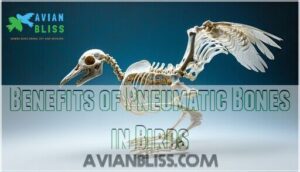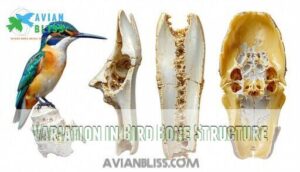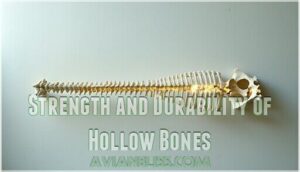This site is supported by our readers. We may earn a commission, at no cost to you, if you purchase through links.
 Ever wondered why birds seem to defy gravity with such grace? Their secret weapon is hollow bones – nature’s ingenious design for flight.
Ever wondered why birds seem to defy gravity with such grace? Their secret weapon is hollow bones – nature’s ingenious design for flight.
These lightweight skeletal structures aren’t just empty; they’re actually sophisticated pneumatic systems connected to their respiratory network. By reducing weight while maintaining strength, hollow bones let birds soar effortlessly through the sky.
Think of them like ultra-lightweight carbon fiber frames in high-performance aircraft. Your feathered friends can fly longer, faster, and more efficiently because their bones are engineered for maximum mobility.
Each hollow bone acts like a built-in air sac, helping birds breathe more effectively and stay agile in the air. Want to learn how these remarkable bones work their magic?
Table Of Contents
- Key Takeaways
- Why Do Birds Have Hollow Bones?
- Evolutionary Development of Hollow Bones
- Advantages of Hollow Bones for Flight
- Benefits of Pneumatic Bones in Birds
- Variation in Bird Bone Structure
- How Birds Maintain Bone Health
- Strength and Durability of Hollow Bones
- Significance of Hollow Bones in Bird Diversity
- Evolutionary Advantage of Hollow Bones in Birds
- Additional Benefits of Hollow Bones in Birds
- Hollow Bones and Enhanced Mobility in Flight
- Frequently Asked Questions (FAQs)
- Why are bird bones hollow?
- Why do flight birds have fewer hollow bones?
- Why is a bird’s beak hollow?
- Why do migratory birds have hollow bones?
- Are hollow bones bad for birds?
- Why are bird bones so strong?
- Why do birds have bones?
- Are birds’ hollow bones good for reducing weight?
- Why do seabirds have hollow bones?
- Why did birds develop hollow bones?
- Conclusion
Key Takeaways
- You’ll discover that hollow bones aren’t just lightweight structures, but sophisticated pneumatic systems directly connected to birds’ respiratory networks, allowing them to breathe more efficiently and maintain incredible aerial performance.
- By reducing skeletal weight while maintaining strength, birds transform their bones into high-performance "airframes" that enable longer, faster, and more agile flight, with internal struts providing remarkable structural integrity.
- Your feathered friends use their hollow bones as multi-functional adaptations that do more than support flight – they help with thermoregulation, enhance respiratory efficiency, and create built-in air sacs that optimize oxygen intake during complex aerial maneuvers.
- These remarkable bone structures represent millions of years of evolutionary engineering, allowing birds to dominate the skies by balancing strength, mobility, and energy conservation in a way that turns gravity from a constraint into a playground.
Why Do Birds Have Hollow Bones?
Have you ever marveled at a sparrow’s effortless flight? Their secret weapon is a stunning example of nature’s engineering: pneumatized bones.
Unlike mammalian skeletons, bird bones are intricate networks of air-filled chambers directly connected to their respiratory system. These aren’t just empty spaces—they’re reinforced with internal struts, mimicking the structural integrity of architectural frameworks.
Over 90% of bird species showcase this remarkable bone density adaptation, which varies by species-specific requirements. Your local sparrow’s bones are actually denser than human bones, yet their specialized internal architecture creates a lightweight skeleton perfect for flight mechanics.
This evolutionary marvel balances strength and respiratory efficiency, transforming bird anatomy into a masterpiece of aerodynamic design. Nature’s blueprint enables birds to defy gravity with incredible grace. The unique characteristics of bird anatomy, including their hollow bone structures, play a pivotal role in their ability to fly efficiently.
Evolutionary Development of Hollow Bones
Nature’s blueprint for bird evolution reveals a fascinating journey of bone formation. Imagine ancient creatures transforming their skeletal structures through remarkable genetic factors and environmental challenges.
Fossil records tell an incredible story of adaptation:
- Theropod dinosaurs developed initial pneumatization mechanisms
- Gradual skeletal lightening became a survival strategy
- Developmental biology favored increasingly specialized bone structures
- Evolutionary pressures refined pneumatic bone capabilities
Hollow bones didn’t just happen overnight—they emerged through millions of years of strategic biological engineering. Imagine dinosaur ancestors experimenting with air-filled cavities, slowly crafting the lightweight yet strong skeletal structure we marvel at today.
These incremental changes in bird anatomy transformed simple bone formations into sophisticated pneumatized wonders, setting the stage for aerial mastery. The development of hollow bones is closely linked to the bird dinosaur connection that enabled birds to achieve flight.
Advantages of Hollow Bones for Flight
You’ve probably wondered how birds soar through the sky with such grace and ease, and their secret lies in those fascinating hollow bones.
These remarkable structures aren’t just empty spaces, but complex adaptations that transform birds into aerial acrobats, enabling them to slice through the air with incredible efficiency and strength.
Reducing Weight
Imagine if your skeleton could help you soar through the sky!
Bird hollow bones aren’t just empty spaces – they’re sophisticated engineering marvels designed for weight reduction and structural strength.
| Feature | Weight Reduction Strategy |
|---|---|
| Bone Structure | Internal struts |
| Density | Higher than mammal bones |
| Composition | Air-filled cavities |
| Strength | Reinforced design |
| Efficiency | Optimized skeletal mass |
These lightweight skeletons transform avian anatomy into an incredible flying machine.
By strategically reducing weight without compromising durability, birds achieve a remarkable balance.
Their hollow bones act like carbon-fiber frames – incredibly light yet strong enough to withstand dynamic flight pressures.
Just like a precision-engineered racing bike, these bones maximize performance while minimizing unnecessary mass.
Increasing Flying Abilities
The skeletal symphony of bird flight reveals a marvel of evolutionary engineering.
Hollow bones aren’t just weight-savers; they’re sophisticated flight machines that transform wing efficiency into an art form. These pneumatized bones create an aerodynamic boost that lets birds slice through air resistance with remarkable precision.
Your typical bird’s lightweight skeleton contains internal struts that provide incredible strength, allowing rapid maneuvers that would challenge traditional solid-bone designs. As eagles soar and sparrows dart, their hollow bones work overtime – connecting air sacs, regulating body temperature, and generating incredible lift.
The intricate bone structure acts like a built-in performance enhancer, enabling birds to execute split-second turns and maintain prolonged flight with minimal energy expenditure. It’s nature’s ultimate flight mechanics package, proving that true innovation often comes from the most unexpected adaptations.
Benefits of Pneumatic Bones in Birds
You’ve probably wondered how birds soar so effortlessly through the sky, and the secret lies in their incredible pneumatic bones.
Nature’s hollow bones: transforming gravity into poetry, turning lightweight skeletons into breathtaking aerial masterpieces of evolution.
These remarkable air-filled structures aren’t just about being lightweight, but they’re a sophisticated biological marvel that connects breathing and flight in ways you’d never imagine, making their ability to fly a true biological marvel.
Enhanced Respiratory Efficiency
Ever wondered how birds manage to breathe so efficiently while soaring through the skies? Their pneumatized bones aren’t just a cool trick—they’re a respiratory superhighway!
- Air Sacs Magic: Interconnected throughout their skeletal framework
- Unidirectional Airflow: Constant oxygen supply unlike any other animal
- Bone-Breathing Interaction: Gas exchange occurs right through bone cavities
- High-Altitude Performance: Maximized oxygen extraction at incredible heights
Your feathered friends have a breathing system that’s like a well-oiled machine. Their hollow bones act as additional lung extensions, allowing birds to gulp down oxygen twice as effectively as mammals.
It’s nature’s own high-performance respiratory upgrade—turning every breath into a power boost for flight!
Lightweight Yet Strong
You’ll be amazed by birds’ bone engineering, their pneumatized bones are like high-performance aerospace designs, combining incredible strength with remarkable lightness.
Dense materials packed with internal struts create a skeletal structure that’s anything but fragile, these hollow bones, reinforced with cross bridges, optimize the strength-to-weight ratio for maximum aerodynamic efficiency.
Each bone acts like a precision-engineered component, balancing weight reduction with structural support, it’s nature’s elegant solution to flight, transforming what seems delicate into a powerhouse of avian mobility, with aerodynamic efficiency.
Thermoregulation and Buoyancy
When birds take flight, their hollow bones work overtime as natural thermal regulators.
These pneumatized bones aren’t just lightweight; they’re sophisticated heat management systems.
By trapping air spaces, they reduce thermal loss and create perfect buoyancy control.
Imagine ducks gliding effortlessly on water, their bone structure acting like a built-in temperature and flotation mechanism—nature’s ingenious design at work.
Variation in Bird Bone Structure
You’ve probably wondered why bird bones look so different across various species, and there’s a fascinating scientific explanation behind their unique structural variations.
When you explore the domain of avian anatomy, you’ll discover that bird bone structures aren’t just random, but carefully evolved adaptations that help different bird species survive and thrive in their specific environments, which is a result of carefully evolved adaptations to help them survive and thrive.
Types of Birds and Bone Adaptations
Exploring the diverse world of avian anatomy reveals fascinating variations in bird bone structures.
Different species develop unique skeletal systems suited to their survival needs. Hawks and eagles sport denser leg bones for powerful prey capture, while nimble songbirds maintain lightweight pneumatic bones for agile flight.
Your journey through bird physiology shows how bone density directly influences strength and mobility, much like an engineer designing the perfect airframe.
Nature’s blueprint adapts perfectly to each bird’s lifestyle.
Adaptations for Diving Birds
The diversity of bone density reveals nature’s ingenious design for aquatic birds.
These underwater specialists trade aerial agility for remarkable diving prowess through unique skeletal adaptations:
- Solid bones reduce buoyancy, enabling deep water penetration
- Specialized neck muscles protect against high-speed water entry
- Strategic skull air sacs shield brains from intense underwater pressure
Loons and auklets exemplify how bone structure directly influences diving techniques, with legs positioned far back and powerful webbed feet driving underwater propulsion.
Their pneumatized bones and feather structure transform them into true aquatic acrobats, showcasing unique skeletal adaptations.
How Birds Maintain Bone Health
You’ll want to understand how birds keep their hollow bones strong and healthy through remarkable adaptations.
Their calcium-rich diet and efficient respiratory systems work together to maintain bone density and structural integrity, ensuring these incredible avian skeletons can withstand the demanding challenges of flight.
Calcium-Rich Diet
You’ve probably never thought about how birds keep their hollow bones strong, but it’s a fascinating world of mineral magic.
Their calcium intake is a precision-driven process that would make any nutritionist proud.
Wild birds instinctively hunt for calcium-rich foods like snail shells, tiny pebbles, and specific insects.
In fact, 99% of their body’s calcium gets stored directly in their bone structure, creating a mineral powerhouse that supports their lightweight yet incredibly strong skeletal system.
The importance of a balanced diet with adequate calcium supplements is essential for maintaining strong bones.
Think of their bone nutrition like a well-oiled machine – each morsel of food contributes to maintaining bone density and mineral absorption.
These feathered athletes carefully balance their dietary needs, ensuring their pneumatized bones stay resilient enough to support high-energy flight and survival.
Efficient Respiratory Systems
Maintaining strong bones is more than just a calcium game for our feathered friends.
Their respiratory system is a marvel of biological engineering, transforming how oxygen travels through their bodies. Imagine a one-way highway of air that flows continuously through hollow, pneumatic bones – that’s how birds breathe!
Unlike mammals, birds have an extraordinary air sacs network that creates a non-stop oxygen intake system. These air sacs extend into their bones, maximizing respiratory efficiency with each breath.
You’re witnessing a living, breathing mechanism where their skeletal structure actively participates in oxygen exchange. Picture it like a sophisticated ventilation system: while inhaling and exhaling, birds are constantly rejuvenating their oxygen supply.
Their breathing mechanics aren’t just about survival – they’re about thriving, soaring, and pushing the boundaries of what’s possible in the animal kingdom.
Strength and Durability of Hollow Bones
You might think hollow bones make birds weak, but you’d be wrong!
These incredible structures are engineering marvels that provide remarkable strength and durability, supporting birds through complex aerial maneuvers and intense physical challenges, showcasing their remarkable strength.
Lifting Capacity
Have you ever wondered how birds manage such incredible lifting capacity? Their hollow bones are nature’s engineering masterpiece, transforming flight mechanics into pure magic!
Here’s what makes these lightweight bones extraordinary:
- Internal struts distribute force like suspension bridges
- Bone material denser than mammal equivalents
- Air-filled cavities optimize weight reduction
Bird bone structure leverages pneumatization to create remarkable aerodynamic lift. These specialized skeletal systems use strategic air pressure and calcium-rich walls, enabling birds to carry surprising weights while maintaining supreme structural support.
Imagine a skeleton so perfectly designed that it turns gravity into a playground. Each hollow bone acts as a lightweight yet robust marvel, balancing strength and agility with precision that would make any engineer marvel. Nature’s blueprint for flight is nothing short of remarkable, showcasing incredible lifting capacity with hollow bones.
Agility in Flight
Imagine a sparrow darting through a forest, weaving between branches with laser-like precision. Your hollow bones are nature’s secret weapon for airborne agility, transforming flight from mere movement to an art form.
Nature’s hollow bones: lightweight engineering that turns flight into pure poetry, transforming gravity from constraint to playground.
These remarkable skeletal structures give birds extraordinary control in the sky.
- Feathered control emerges from lightweight bones that distribute forces evenly
- Wing flexibility allows split-second directional changes with minimal energy
- Aerodynamic boost enables complex flight maneuvers without structural stress
Each hollow bone acts like a sophisticated gyroscope, letting birds pivot and spiral with breathtaking grace. Their skeletal structure isn’t just about being light—it’s an evolutionary masterpiece of bird flight mechanics.
You’re witnessing millions of years of design that turns the sky into a playground, where agility isn’t just possible—it’s inevitable. The unique bird species characteristics, including aerodynamic features, play a pivotal role in their ability to perform such impressive maneuvers.
Significance of Hollow Bones in Bird Diversity
Every bird species tells a unique story through its bone structure, revealing nature’s ingenious design of avian anatomy.
Hummingbirds boast bones up to 95% hollow, enabling incredible aerial agility and precise hovering. Diving birds like penguins showcase denser bones adapted for underwater hunting, demonstrating how flight mechanics shape bone density.
From soaring eagles with lightweight frames to ground-dwelling kiwis with more solid structures, each bird’s skeletal composition reflects its ecological niche. These variations in hollow bones highlight the remarkable evolutionary adaptations that support respiratory systems and aerodynamic efficiency across different bird species.
Evolutionary Advantage of Hollow Bones in Birds
You’ve probably wondered how birds soar through the sky with such grace and efficiency, and the secret lies in their incredible hollow bones.
These remarkable bone structures aren’t just empty spaces, but evolutionary masterpieces that transform birds into nature’s most sophisticated aerial engineers.
Dominating The Skies
Eagles and prehistoric flyers didn’t just soar—they engineered biological aircraft through extraordinary Flight Mechanics and Airborne Adaptations.
Their hollow bones transformed avian biology, creating unparalleled Sky Dominance through strategic wing structures:
- Pneumatic bone design enables precision aerial navigation
- Advanced wing architecture maximizes energy conservation
- Evolutionary adaptations create supreme aerodynamic control
These lightweight frameworks represent nature’s most sophisticated flying technology, letting birds claim atmospheric territories with breathtaking efficiency and grace.
The study of aerodynamic designs, such as those found in action shooter games, can provide valuable insights into the mechanics of flight.
Reduction in Weight
Soaring through the skies demands a remarkable weight reduction strategy that birds have mastered with their ingenious hollow bones. Your feathered friends possess a skeletal system that’s a marvel of lightweight design, transforming what could be heavy structures into aerial perfection.
These pneumatic bones aren’t just empty spaces – they’re engineering marvels that balance structural strength with minimal weight. Here’s how birds achieve their incredible lightweight design:
- Skeletal structure 75% lighter than comparable mammals
- Air-filled bone cavities connected to respiratory systems
- Internal struts providing maximum strength with minimal mass
- Specialized bone density adapted to specific flight requirements
These lightweight bones let birds pack more muscle and fuel, turning their bodies into precision flying machines. By reducing weight without compromising strength, birds have cracked nature’s code of efficient mobility. Their hollow bones aren’t a weakness – they’re a superpower that enables breathtaking flight and unparalleled aerial freedom.
Additional Benefits of Hollow Bones in Birds
You’ll be amazed to discover that hollow bones aren’t just about making birds lighter—they’re nature’s incredible multitool for survival.
These remarkable bone structures offer birds faster thermoregulation and could even inspire groundbreaking medical technologies that might revolutionize human healthcare.
Faster Thermoregulation
Bird bones are more than just structural marvels—they’re sophisticated thermal regulators. The pneumatic bone structure creates a unique heat transfer mechanism that puts human cooling systems to shame.
Air-filled cavities thread through bones like miniature climate control networks, rapidly dispersing excess warmth during intense activities.
| Thermal Feature | Bird Advantage |
|---|---|
| Heat Dissipation | Lightning-fast |
| Temperature Stability | Remarkable |
| Cooling Efficiency | Superior |
Imagine your body struggling to maintain temperature while a bird’s lightweight design guarantees instant thermal balance. These hollow bones act as natural radiators, with air spaces providing incredible insulation.
Through pneumatization, birds achieve near-instant temperature regulation, allowing them to thrive in environments that would challenge other creatures.
Potential Medical Advancements
Because medical innovations inspired by avian anatomy could transform healthcare, researchers are diving deep into bird bone biology.
Hollow bones offer groundbreaking insights for biomechanical research, presenting extraordinary opportunities for medical advancement:
- Lightweight prosthetics that mimic bird bones’ strength-to-weight ratio, creating more comfortable artificial limbs
- Advanced bone regeneration techniques leveraging unique avian skeletal structures
- Aerodynamic medical implants designed to reduce patient strain while maintaining durability
Cutting-edge studies explore how respiratory innovations from hollow bone structures can revolutionize fracture treatment. The internal architecture of bird bones provides a remarkable blueprint for creating medical devices that put less stress on patients’ bodies.
Researchers are also exploring the benefits of prosthetic devices in rehabilitation.
From joint replacements to spinal implants, nature’s design proves that sometimes the most ingenious solutions come with feathers. By understanding hollow bones’ biological optimization, scientists are reshaping our approach to medical engineering, turning avian adaptations into human healthcare breakthroughs.
Hollow Bones and Enhanced Mobility in Flight
You’ve probably wondered how birds manage to zip through the sky with such incredible grace and speed.
Their secret weapon? Hollow bones that transform their skeletal structure into a high-performance flight machine, giving them unparalleled mobility and agility that’ll make your jaw drop, thanks to their hollow bones.
Higher Mobility
When a hawk glides through open skies, its hollow bones transform flight mechanics into an art form.
These lightweight skeletal structures provide an aerodynamic boost, reducing body weight and enabling incredible wing movement.
By minimizing air resistance, birds achieve extraordinary flexibility and precision.
Their skeletal strength allows rapid directional changes with minimal energy expenditure.
Imagine nature’s perfect design: a body engineered for maximum maneuverability, where every bone contributes to breathtaking aerial performance.
The unique bird species characteristics, such as aerodynamic features, play a vital role in their ability to fly efficiently.
Increased Agility
Darting through your garden like a living lightning bolt, a hummingbird demonstrates the extraordinary potential of hollow bones and wing flexibility. These remarkable avian athletes showcase nature’s most sophisticated flight adaptations, turning aerial movement into an art form.
Their lightweight skeletal structure provides an incredible aerodynamic boost that enables split-second maneuvers with minimal energy expenditure. The key features of this structure include:
- Pneumatic bone composition supports rapid directional changes
- Hollow bones reduce weight without sacrificing strength
- Wing flexibility allows instantaneous aerial repositioning
- Enhanced mobility transforms flight into precise choreography
- Skeletal adaptations maximize energy efficiency during complex flight patterns
Imagine your body as a high-performance aircraft, where every structural element is painstakingly designed for maximum agility. That’s the marvel of bird bone composition – a tribute to evolutionary engineering that turns flight into poetry. The study of bird bone supplements reveals the importance of bone health benefits in maintaining these unique skeletal structures, highlighting the significance of bird bone composition and aerodynamic boost in their flight capabilities.
Frequently Asked Questions (FAQs)
Why are bird bones hollow?
Ever wondered how birds defy gravity?
Their pneumatized bones aren’t just lighter—they’re sophisticated respiratory extensions that boost oxygen intake, enhance flight efficiency, and connect directly to air sacs.
Making aerial navigation a breathtaking marvel.
Why do flight birds have fewer hollow bones?
You’ll discover that flight birds don’t necessarily need fewer hollow bones.
Their unique respiratory system and bone structure actually support efficient oxygen intake and flight performance, making pneumatized bones essential for aerial adaptation.
Why is a bird’s beak hollow?
You’ll find a bird’s beak isn’t actually hollow.
Instead, it’s a lightweight structure made of keratin with blood vessels and nerves, designed for precise manipulation and survival tasks like feeding, defense, and temperature regulation.
Why do migratory birds have hollow bones?
You’ll appreciate how migratory birds‘ hollow bones help them survive epic journeys by reducing weight, improving oxygen efficiency, and connecting their respiratory system to enhance energy transfer during long-distance flights.
Are hollow bones bad for birds?
Hollow bones are a bird’s superpower, not a weakness! They’re densely fortified, pneumatized structures that strengthen flight, enhance respiratory efficiency, and provide vital support for birds’ incredible aerial adventures.
Why are bird bones so strong?
Bird bones pack incredible strength through dense materials, internal struts, and mineral-rich structures.
They’re engineered like precision airframes, using crisscrossing reinforcements that withstand intense flight pressures while remaining lightweight and remarkably durable.
Why do birds have bones?
You carry skeletal structures that support movement, protect essential organs, and anchor muscles.
These incredible frameworks help you stand, breathe, and interact with the world around you, serving as your body’s essential internal scaffolding.
Are birds’ hollow bones good for reducing weight?
You’ve heard myths, but hollow bones don’t actually make birds lighter.
They’re denser and stronger, packed with air sacs that boost oxygen intake and support flight’s incredible energy demands.
Making them evolutionary marvels.
Why do seabirds have hollow bones?
Ever wondered how seabirds soar so effortlessly?
Their hollow bones aren’t just lightweight; they’re air-conditioned respiratory extensions that boost oxygen intake, enhance buoyancy, and help them navigate vast marine environments with incredible efficiency.
They help them navigate vast marine environments with incredible efficiency.
Why did birds develop hollow bones?
You’ve got a superpower in your skeleton!
Nature designed hollow bones to boost oxygen intake and strengthen flight muscles, turning birds into high-performance aerial machines.
This design turns birds into high-performance aerial machines that navigate the sky with incredible efficiency.
Conclusion
Imagine the sky as a bird’s playground, where hollow bones are their ultimate superpower.
You’ve discovered why birds have hollow bones – nature’s remarkable design for lightweight, high-performance flight.
These incredible pneumatic structures aren’t just empty spaces; they’re engineering marvels that let birds soar effortlessly.
By understanding why birds have hollow bones, you’ll appreciate how evolution crafted the perfect flying machine, transforming these creatures into masters of aerial mobility and efficiency.













